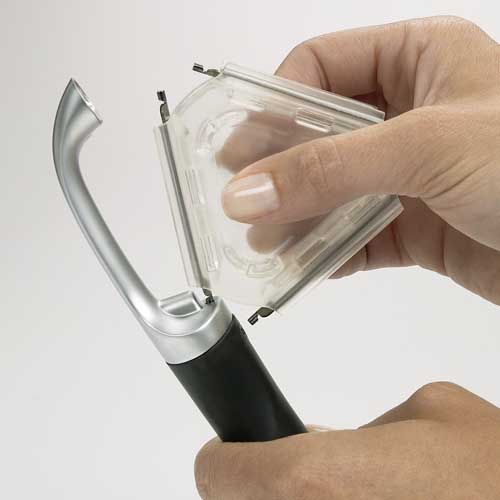A swivel peeler is a kitchen tool that can be used to peel vegetables and fruits. It does not have blades, but rather tiny little teeth on the end of its head.
These teeth can get dull after prolonged use if they are not sharpened periodically. This article provides how-to tips for how to sharpen a swivel peeler so you don’t need to buy a new one!

Steps on Sharpening a Swivel Peeler
Step 1. Take a sharpening stone and grind the teeth down on one side. Make sure that you have plenty of space in case bits fly off! Be careful how much pressure you use as this may cause your peeler to snap altogether if it is not strong enough for grinding.
Step 2. Hold the blade perpendicular to the sharpening stone, carefully moving the peeler back and forth. This will sharpen your blade without having to touch it with a sharpening stone or file, which could damage how well it works in the future.
Step 3. Take care of your blades by washing them after use and before storing them away. Some people choose to store their swivel peeling head inside its handle so that it is not exposed to bacteria and other things.
Step 4. You can also use a wet cloth or towel to take off any stubborn food residue from the blade before storing them away in a drawer for later use.
How to Use a Swivel Peeler
The swivel peeler has a blade that is usually made of metal and rotates around the handle. You can buy them for less than $15 at any grocery store or kitchen supply shop, which means you don’t have to invest in expensive equipment if you are just starting.
Place the peeled fruit on the cutting board and position the blade on top of it. The swivel peeler will glide through the skin with a lot less effort and in much fewer strokes than if you were to use other types of knives or blades.
Hold onto one side of the handle, place your thumb on the end closest to the blade, and pivot around while rotating your wrist.
Keep doing this until the skin is completely peeled off.
Turn the handle around to see how much peel has been removed and make sure not to pierce through the other side of the fruit as you would with a knife (or risk cutting your fingers).
How to Care for Swivel Peeler
Rinse the peeler under running water and use a clean cloth to gently wipe away any residual food.
It is advised to put your swivel peeler in hot, soapy water after every few uses for better sanitation. Cleaning it with dish soap mixed with warm tap water should do the trick – remove the blade and make sure to get the inside of the handle as well.
After washing it, dry your peeler with a clean dish towel or paper towels before storing it in its designated spot (usually next to any other kitchen utensils).
You should also not store this type of tool near anything too acidic like vinegar or lemon juice, or anything too basic like baking soda.
If you’ve had your peeler for a while and it starts to show signs of wear and tear (e.g., the blade becomes loose), take it to be sharpened by a professional, as doing so at home can easily damage the tool even further.
Swivel peelers are designed for ease of use, but they also require more care than standard blades.
The last thing you want is to have your peeling process slowed down by a dull blade!
How to Prevent Damaging on a Swivel Peeler
Keep your peeler as dry as possible.
Wash and clean it with a dishcloth every time you use it, especially after peeling something very acidic or basic in nature (e.g., tomatoes or onions). This helps keep the blade from becoming too corroded.
When storing for long periods of time, keep it in a dry place, such as your utensil drawer.
When using the peeler to slice or dice vegetables (e.g., celery), do so before peeling them with the swivel peeler. This will help reduce how often you need to sharpen it and ensure its longevity!
How to Clean a Swivel Peeler
Grab a dishcloth and rub the peeler’s blade against it. This will absorb any food or particles that might have gotten stuck on it.
If there are tough foods like onion skin, use warm water to rinse out all of the residues before air drying for about 15 minutes. Then cover with a cloth and store in your utensil drawer.
To remove hard to reach areas like the blade, use a toothbrush and scrub at any debris that has accumulated.
If you’re unable or don’t want to clean your swivel peeler by hand, place it in boiling water for about two minutes before removing and drying with a dishcloth again.
Once in a while, use an old toothbrush to scrub the blade.
